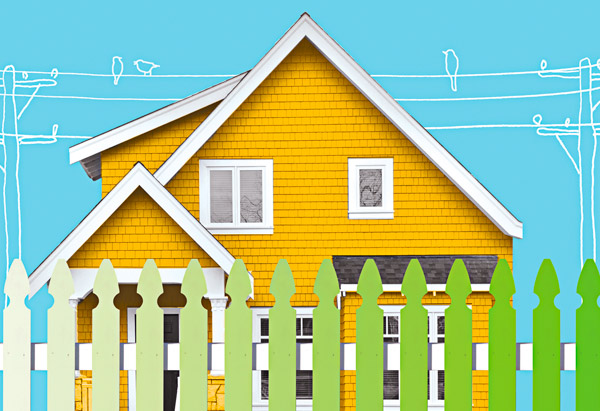If gas and electric costs are leaving you cold, you can seal up drafts, add insulation—or even move into a futuristic heat-harnessing home.

Illustration by David Drummond
A $250 heating bill. A $300 air-conditioning bill. The costs add up. And while you wouldn't leave a window open year-round, your house may be doing the equivalent for you, if it's riddled with drafty air ducts, insulation gaps, and leaky seams. To cut costs and do their small part for the planet, some families are moving into "passive houses," which use roughly one-fifth the energy of a regular home and slash heating costs by as much as 90 percent.
Passive homes are virtually airtight, extraordinarily well-insulated buildings that harvest heat generated inside the house—and keep it there. Materials like concrete and granite act as thermal storage units, soaking up heat from household electronics and even residents' bodies. Specially treated windows capture more sunlight. (In warmer climates, reflective windows are installed to keep the home from feeling like an oven.) Constant air exchange between indoors and outdoors keeps things from getting stale, and, yes, you can open the windows.
Passive certification is one of the world's most stringent standards for energy-efficient construction. These principles were actually developed in the United States and Canada in the mid-1970s but didn't catch on because energy prices here were so low at the time, there wasn't enough incentive to invest. Not so in Germany, where, in the '90s, engineers and architects embraced the concept and refined and strengthened the standards. More than 30,000 passive buildings have since been constructed in Europe (called Passivhaus there). Now passive design is swinging back Stateside: Dozens of residential and commercial projects are in the works from Oregon to North Carolina, and by the end of the year, 200 American families could be living in passive homes.
"If you can be comfortable by passive means, rather than actively burning fossil fuel, that's ideal," says Katrin Klingenberg, executive director of Passive House Institute U.S., which grants certification. "A building that is almost self-sufficient is a beautiful thing." She also points out that the higher up-front costs (up to 15 percent for new buildings) pay off handsomely in the long run.
Next: From basic to advanced, three ways to save on energy costs at home
Passive homes are virtually airtight, extraordinarily well-insulated buildings that harvest heat generated inside the house—and keep it there. Materials like concrete and granite act as thermal storage units, soaking up heat from household electronics and even residents' bodies. Specially treated windows capture more sunlight. (In warmer climates, reflective windows are installed to keep the home from feeling like an oven.) Constant air exchange between indoors and outdoors keeps things from getting stale, and, yes, you can open the windows.
Passive certification is one of the world's most stringent standards for energy-efficient construction. These principles were actually developed in the United States and Canada in the mid-1970s but didn't catch on because energy prices here were so low at the time, there wasn't enough incentive to invest. Not so in Germany, where, in the '90s, engineers and architects embraced the concept and refined and strengthened the standards. More than 30,000 passive buildings have since been constructed in Europe (called Passivhaus there). Now passive design is swinging back Stateside: Dozens of residential and commercial projects are in the works from Oregon to North Carolina, and by the end of the year, 200 American families could be living in passive homes.
"If you can be comfortable by passive means, rather than actively burning fossil fuel, that's ideal," says Katrin Klingenberg, executive director of Passive House Institute U.S., which grants certification. "A building that is almost self-sufficient is a beautiful thing." She also points out that the higher up-front costs (up to 15 percent for new buildings) pay off handsomely in the long run.
Next: From basic to advanced, three ways to save on energy costs at home
How to Curb Energy Costs
Sealing your space up tight and fixing other trouble spots can save as much as 30 percent on your energy bills. Here's our three-stage plan to get you started.Basic: Know Your Home
You've heard you should do a home energy audit, but what exactly does that mean? Certified home energy raters will conduct a blower door test, putting a powerful fan in your doorway to send air outward through all the tiny holes that let in cold or heat; gauges identify the extent of air leakage. Infrared scans may also show energy culprits like spaces between drywall. Your utility company may offer free audits; or visit energystar.gov to find a home energy rater in your area.Labor: None
Cost: Up to $500
Intermediate: Fill the Gaps
Homes built before 1970 can have so much seepage that the entire volume of air inside is replaced by air from outside in 40 minutes. Yet air infiltration is one of the easiest problems to correct. After identifying leaky spots, hit the hardware store for a caulking gun and some caulk or insulating foam. Then check out the Green Dream Group on YouTube for tutorials on filling spaces around outlets and window frames. Sealing your home can trim your bill by as much as 9 percent.Labor: Moderate
Cost: Under $50
Advanced: Reinsulate
Especially in older homes, poor wall insulation makes it hard to maintain a comfortable temperature without cranking the heat or A/C. Check your attic, basement, and crawl spaces to see if you have full coverage. Adding insulation can cost anywhere from 15 cents to $4 per square foot, depending on what type you use, and it may take years to recoup your investment. But if you've completed stages 1 and 2, adding insulation can save you more than $200 a year.Labor: Heavy
Cost: From a few hundred dollars to thousands
More Budget-Friendly Fixes for Your Home




